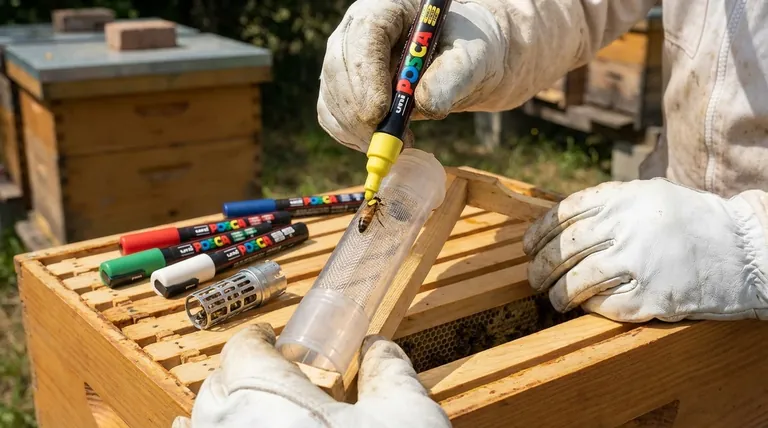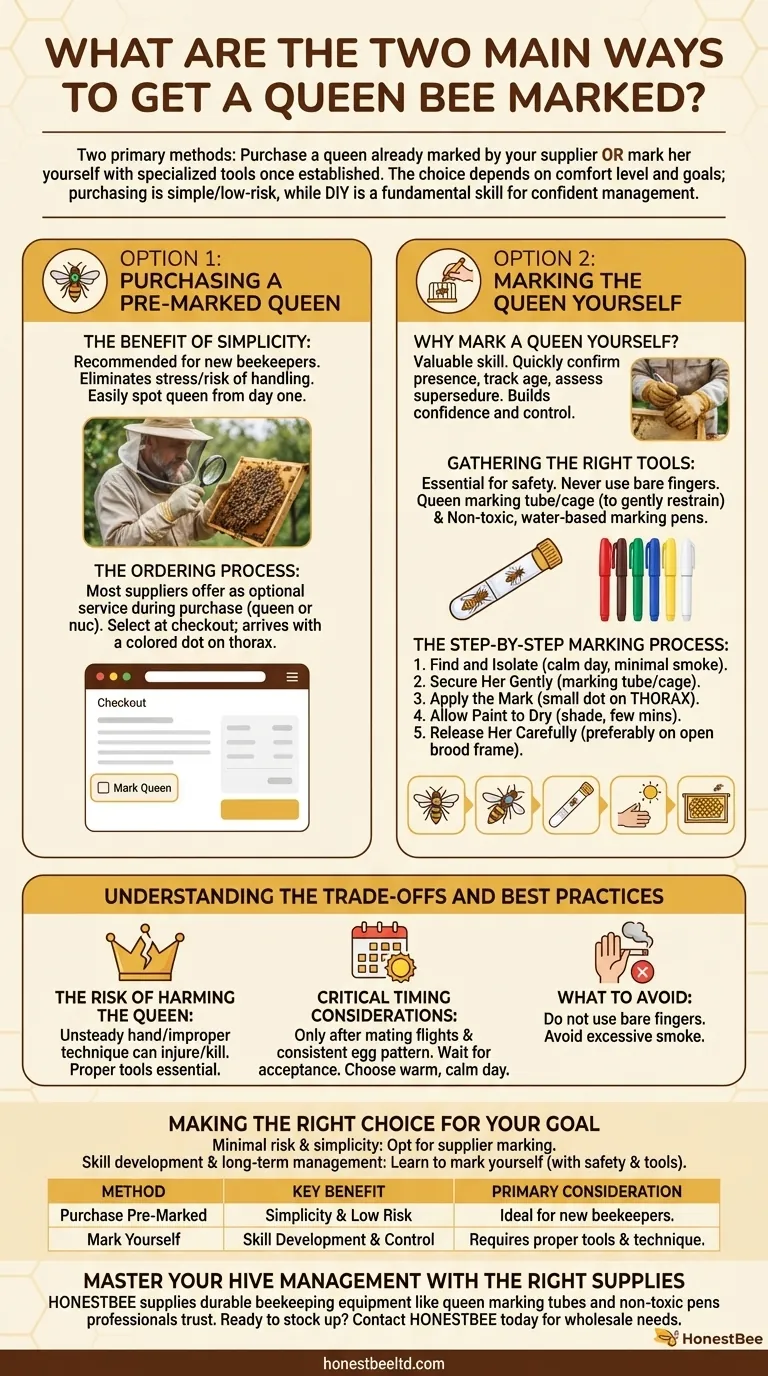There are two primary methods for getting a queen bee marked. You can either purchase a queen that has already been marked by your bee supplier, or you can undertake the task of marking her yourself using specialized tools once she is established in your hive.
Choosing between a pre-marked queen and a do-it-yourself approach hinges on your comfort level and beekeeping goals. While purchasing a marked queen is the simplest and lowest-risk option, learning to mark her yourself is a fundamental skill for confident hive management.

Option 1: Purchasing a Pre-Marked Queen
The Benefit of Simplicity
For new beekeepers, requesting a marked queen from a supplier is the recommended path. It eliminates the stress and potential risk associated with handling the most important bee in the colony.
This ensures you can easily spot your queen from day one without needing a steady hand or specialized equipment, allowing you to focus on other aspects of hive health.
The Ordering Process
Most reputable bee suppliers offer queen marking as an optional service when you purchase a queen or a nuc. You simply select this option during the checkout process, and she will arrive with a small, colored dot on her thorax.
Option 2: Marking the Queen Yourself
Why Mark a Queen Yourself?
Marking your own queen is a valuable beekeeping skill. It allows you to quickly confirm her presence during inspections, track her age using the international color code, and more easily assess if she has been superseded.
Successfully marking a queen builds confidence and gives you greater control and insight into the lifecycle of your colony.
Gathering the Right Tools
To mark a queen safely, you must use the correct equipment. You cannot simply grab her with your fingers.
The essential tools are a queen marking tube or a queen marking cage to gently restrain her, and a set of non-toxic, water-based queen marking pens.
The Step-by-Step Marking Process
- Find and Isolate the Queen: On a calm day, inspect your brood frames until you locate the queen. Use minimal smoke, as too much can cause her to hide.
- Secure Her Gently: Use your marking tube or cage to gently confine her. A tube uses a soft foam plunger to press her against a screen, while a cage can be pressed over her directly on the comb.
- Apply the Mark: Dab a small dot of paint from your marking pen onto the center of her thorax (the middle section of her body). Never mark her head or abdomen.
- Allow the Paint to Dry: Keep the queen safely confined for a few minutes in the shade to allow the paint to dry completely. This prevents the paint from smearing onto other bees.
- Release Her Carefully: Gently release the queen back onto a frame, preferably one with open brood. Carefully place the frame back in the hive, avoiding any chance of crushing or "rolling" her between frames.
Understanding the Trade-offs and Best Practices
The Risk of Harming the Queen
Marking a queen yourself carries inherent risks. An unsteady hand or improper technique can injure or kill her, which would be a major setback for the colony. Using proper tools is not optional; it is essential for her safety.
Critical Timing Considerations
The timing of your marking is crucial. You should only mark a queen after she has taken her mating flights and has begun laying a consistent egg pattern. Marking a virgin queen can interfere with her mating and acceptance.
Wait until the colony has fully accepted her and settled into a routine. Choose a warm, calm day to minimize stress on both the bees and yourself.
What to Avoid During the Process
Do not attempt to mark a queen by holding her with your bare fingers unless you are an experienced expert. The risk of crushing her is too high.
Furthermore, avoid using excessive smoke during your inspection, as it can agitate the colony and cause the queen to run and hide, making her much harder to find and capture safely.
Making the Right Choice for Your Goal
Deciding how to get your queen marked is a practical choice that depends on your experience level and goals as a beekeeper.
- If your primary focus is minimal risk and simplicity: Opt to have your supplier mark the queen before she is delivered.
- If your primary focus is developing your skills and long-term colony management: Learn to mark the queen yourself, following all safety best practices and using the correct tools.
Mastering this skill is a significant step toward becoming a more observant and self-sufficient beekeeper.
Summary Table:
| Method | Key Benefit | Primary Consideration |
|---|---|---|
| Purchase Pre-Marked | Simplicity & Low Risk | Ideal for new beekeepers; ensures easy identification from day one. |
| Mark Yourself | Skill Development & Control | Requires proper tools (marking tube/cage, pens) and careful technique to avoid harming the queen. |
Master Your Hive Management with the Right Supplies
Whether you're a commercial apiary manager or a beekeeping equipment distributor, having reliable, high-quality tools is essential for successful colony management. HONESTBEE supplies the durable beekeeping equipment—like queen marking tubes and non-toxic pens—that professionals trust.
Ready to stock up on the supplies that build beekeeping confidence? Contact HONESTBEE today to discuss your wholesale needs and ensure your operations run smoothly.
Visual Guide

Related Products
- Queen Bee Marking Pen POSCA Queen Marking Pens for Beekeeping Bee Markers
- Queen Bee Marking Pen UNI Medium Point for Queen and Bee Marking
- Queen Bee Marking Tube Cage Bottle Catcher Holder with Clear Plastic Plunger Marker
- Wooden Queen Bee Excluder for Beekeeping
- Professional Plastic Queen Excluder for Modern Beekeeping
People Also Ask
- What type of markers are commonly used for marking Queen bees? Choose the Safe, Non-Toxic Standard
- What are the benefits of marking a Queen bee for hive management? Boost Efficiency & Colony Health
- What are the Queen marking colors associated with specific years? Master Hive Management with the 5-Year Color Code
- What are the benefits of marking a queen bee? Boost Efficiency & Hive Health
- Where is the queen bee typically marked? A Guide to Safe & Effective Queen Identification



















